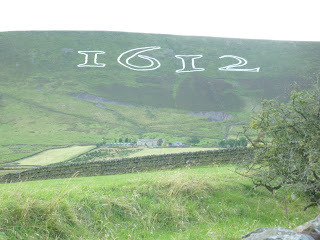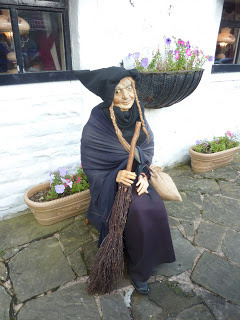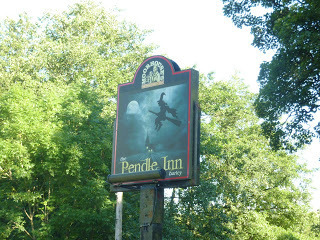Martin Edwards's Blog, page 240
August 19, 2012
Pendle and the Witches






A highlight of a very enjoyable week-end was my first ever visit to Pendle, home of the legendary witches. I live only an hour’s drive from Pendle Hill, so there’s really no excuse for the fact that I’ve never visited this fascinating – and very attractive – part of Lancashire before.
All the more so since, back in 2005, I wrote a story for one of Mike Ashley’s anthologies of historical whodunits, the plot of which was influenced by the story of the Pendle witch trials. However, I set the events in familiar territory, my home county of Cheshire. The story was called “The Witching Hour” and it's one of my least well-known stories, though maybe one day it will enjoy a new life thanks to digital publication.
As it happens, now is an especially good time to go to Pendle. 2012 sees the 400th anniversary of the famous trials and I was startled to see the date “1612” picked out, very noticeably, on the hillside. Some locals, I gathered, are not thrilled about this, but it certainly made for a striking image.
Saturday also saw massive celebrations in the nearby village of Barley. The little place was full of life – and witches in full regalia. When we there, some of the women in pointed hats were boogying to the music from a band. A typically quirky English scene, and all the more pleasing because the weather was – for once – fantastic.
Published on August 19, 2012 14:13
August 18, 2012
Panic Button - movie review
Panic Button is a 2011 horror movie which is sensibly short and sharp. Many of its ingredients are genuinely interesting, though whether director Chris Crow made the most of them is debatable.
I really liked the premise. Four youngish people, two men and two women, who participate in a social networking site, win a dream trip by private jet to New York. But when a disembodied voice invites them to play some in-flight games, events take a sinister turn. What are the secrets of the four passengers, and why have they been chosen for the trip?
We have been prepared for something grim by the fact that, before the credits rolled, one of the character’s homes was invaded by masked intruders. Events on the flight become progressively darker as the m minutes pass, although I could never figure out why the plane was actually – as the luckless quartet discover – heading, not for New York, but for....Norway.
The pace of the film doesn’t quite disguise the various plot holes. There is an intelligent idea – about the dangers of social networking, and in particular bullying in cyberspace – at the heart of the story, but it is rather lost in the frenetic action. So the film is exciting, on a superficial level, but in some ways a bit of a mess if one stops to analyse it. The final twist, though clever, comes completely out of the blue, and some foreshadowing would have been a good idea. A bit more characterisation – not least of the villain of the piece – would also have helped. All in all, a film worth watching, but not as good as it could have been.
Published on August 18, 2012 13:45
August 16, 2012
Forgotten Book - The Castleford Conundrum
When a crime writer chances upon a terrific idea for a mystery story, it’s a great feeling. It may be a fresh idea about character, say, or relationships. During the Golden Age of detective fiction, it was often a novel method of murder. But whatever the idea may be, however marvellous it may seem, one needs to keep it under control. For an idea that gets out of hand can create fundamental problems, for instance with credibility.
This is my reservation about an interesting, but in my opinion significantly flawed, novel by J. J. Connington, The Castleford Conundrum, which is my choice for today’s Forgotten Book. I’m pretty sure that Connington came up with a particular plot twist, neatly derived from legal precedents, and wove his story around it. Fair enough – in fact, more than 20 years later, another notable writer, Cyril Hare would make use of a very similar idea. But here, at least, I think Connington tested the suspension of disbelief to breaking point.
In many ways, though, this is a typical whodunit of the traditional type. As in so many books written in the Thirties (this one was first published in 1932), the murder victim is a disagreeable and rich individual, who unwisely allows it to be known that she is planning to change her will. Since almost all members of her family are equally unappealing, there is no shortage of suspects when she is found dead. But it is only when Sir Clinton Driffield makes a belated appearance that events start motoring to a conclusion.
Pleasingly, this book has benefited from a recent reprint by Coachwhip Publications, and it includes a welcome and characteristically informative introduction by Curtis Evans. I am a Connington fan, although I’m afraid I don’t rate this book as highly as Curt. The long trudge towards a foreseeable outcome (once you have figured out that central plot gimmick, which I did quite early on) is rather dreary. The book is an example of Connington’s admirable willingness to ring the changes in his plotting, and the book retains a historical interest, at the very least. But I was left wondering this – why on earth did the killer go to so much bother?
Published on August 16, 2012 18:00
August 14, 2012
Gibraltar and Spain








On a bus tour around the Gibraltar last week, the driver played excerpts from a James Bond movie, The Living Daylights, which was shot on the Rock. Yet I can’t think of any crime novel which has featured the Rock – surely there must be some thrillers, at least, set there? It’s certainly a fascinating location, one I enjoyed visiting this time even more than on my first trip more than 20 years ago.
The atmospheric nature of the place is heightened by its proximity to Spain and Africa, and the continuing tension created by political tensions arising from the very evident, and passionately felt, desire of the inhabitants (certainly including our bus driver) to retain their links with Britain. An extraordinary, and evocative, part of the world.
I’ve mentioned before my enthusiasm for cruising, and I’m especially keen on itineraries that don’t have too many days at sea, but which call in to a wide range of ports. This provides the opportunity to sample places and figure out destinations that would be worth prioritising for a longer look. On recent holidays, I’ve been very taken by Santorini, Madeira and Rhodes, and although Gibraltar is tiny, I would be keen to return there before too long.
Three Spanish towns were the other ports of call. Almeria, with its fabulous Alcazaba fortress, and Cartagena, with its marvellous and very well presented Roman remains, were both memorable. And though I’d never been to Mallorca before, having mentally stereotyped it as a beach holiday type of place, I found Palma really impressive. Will any of these locations feature in future short stories? Not sure – I still haven’t finished the mystery I’ve set on Santorini yet...
By the way, I couldn't resist including a photo not only of a wonderful Barbary macaque family, but also one in which I'm accompanied by my recently appointed publicist! Catherine hopes to develop a career in PR or journalism when she finally leaves Oxford. Suffice to say that if she manages to improve my profile, she'll surely be able to rise to any other challenge!
Published on August 14, 2012 16:30
August 13, 2012
Ruth Rendell's Thriteen Steps Down - ITV review
Thirteen Steps Down, by Ruth Rendell, is one of her more striking books of the last ten years, and so I looked forward to tonight’s first part (of two) of an ITV adaptation with much relish. At one time, Rendell mysteries were impossible to avoid, even in the unlikely event that you wanted to avoid them. They were a staple of the television schedules (apparently ITV produced more than 80 Rendell stories, many based on her short stories, and there were BBC adaptations as well). Many of the old episodes keep cropping up on the repeat channels, but this is the first new Rendell on ITV for twelve years. The press pack spoke of Rendell being “rediscovered for television” – blimey, how soon they forget!
Mix Cellini (played by Luke Treadaway) is a mechanic who lives in a London flat and is fascinated by the John Reginald Christie murder case – and also by a glamorous model. Geraldine James, superb in a challenging role as a crotchety octogenariian with an equally strange obsession about a past romance, plays his landlady, Gwendolen, while Elarica Gallagher is the model.
Mix is a good example of a typical Rendell protagonist – a superficially attractive, but deeply troubled youngish man whose obsessions and warped moral values lead to calamitous consequences. Treadaway veered more towards unpleasant than appealing in his portrayal of Mix, and I felt this was a mistake; it's the apparent charm of Rendell's sociopaths that makes them so memorable.
When I started planning The Arsenic Labyrinth, I decided to experiment by introducing a key character, Guy, who was in the mould of a Rendellesque sociopath, and I enjoyed enormously writing those scenes in which Guy appeared. That was my small tribute to a genius of the genre, even though the book itself was rather different from anything Rendell has produced (not least because it is very rare for her to venture north of the London that she knows, and conveys, so well!)
I’ve often said in interviews that Rendell is the living crime writer whom I most admire; her work has given me enormous pleasure ever since I first read the brilliant The Lake of Darkness. That is still the case, although I do worry that there has been (by her exceptional standards) a bit of a falling-off in her work over the past fifteen years. Themes, and plot elements, have tended to recur, but not with quite the flair of the past, and since she was elevated to the House of Lords, she has made some attempts at political and social comment in her novels, which have seldom worked well. Perhaps some decline is inevitable, especially with a writer who has been so prolific. But this creepy, if at times unsubtle, TV adaptation is a reminder of what a gripping story-teller she is. It's not as good as the book, but I shall certainly be tuning into part two.
Published on August 13, 2012 15:00
August 12, 2012
Casablanca (and Tangier)




Casablanca is a place I’ve fancied visiting ever since I saw the famous movie starring Bogart and Bacall. Not a single scene in the movie, mind you, was actually shot in Casablanca. Another piece of trivia about the film is that the screenplay was based on a stage play that, at the time, had never had a theatrical production. It was called Everybody Comes to Rick’s.
Anyway, I finally satisfied my curiosity about the Moroccan city last week when it was one of the ports visited on a short cruise themed around ‘Moorish delights’. Casablanca turns out to be a vast, bustling commercial hub, its stand-out “sight” being the massive, and massively impressive, Hassan II Mosque, wonderfully situated on a promontory jutting out into the Atlantic.
Another trip was to Tangier, with its colourful old town and markets. It’s a place rich in atmosphere and history, and has featured in various thrillers, including one of the Modesty Blaise stories. Of the two cities, I found more of interest in Tangier, though of the four Moroccan cities I’ve visited, Marrakech remains far and away my favourite.
There’s something fascinating about having the chance of a glimpse of a very different culture, and brief – and inevitably superficial - as my glimpses into Moroccan life have been, they might well surface in a short story one of these days.
Published on August 12, 2012 16:30
August 9, 2012
Forgotten Book - The Murders in Praed Street
Which was the first detective novel to feature a serial killer? I use the term “detective novel” to exclude book such as The Lodger, by Marie Belloc Lowndes, which is a suspense story heavily influence by the crimes of Jack the Ripper, and which Hitchcock turned into a film early in his career.
I stand to be corrected, but the first serial killer detective novel I know of is The Murders in Praed Street, by John Rhode, and that is my Forgotten Book for today. Today, the plot twists may seem shopworn to seasoned whodunit fans, but this was a ground-breaking book when it appeared in 1928, and I enjoyed reading it.
The luckless denizens of Praed Street start to fall victim to a signature killer of considerable ingenuity, and the police are baffled until Dr Priestley helps them out. One of the murders involved the use of “a remarkably virulent synthetic alkaloid”, prompting the good doctor to reminisce about one such alkaloid with which a character in The Ellerby Case “tipped the spines of the hedgehog to which I so nearly fell a victim. You remember that incident, I dare say?” Odd question. Who could forget an attempted murder by hedgehog spines?
Within a few years, serial killer (or “multiple murder”) mysteries became relatively common. Philip Macdonald wrote two, Anthony Berkeley and Francis Beeding had a go too, and Agatha Christie produced that wonderful puzzle The ABC Murders. But Rhode deserves credit for leading the pack. Today, of course, serial killer novels are two-a-penny. I doubt if many of those who read them know the name of John Rhode. And, whatever his literary limitations, I think that is a pity.
[image error]
Published on August 09, 2012 16:30
August 7, 2012
The Underground Man
It is quite some time since I read one of Ross Macdonald's private eye novels featuring Lew Archer, but I was prompted to give him another go by the republication of The Underground Man - and I'm very glad I did. The paperback is one of a number that have now appeared as Penguin Modern Classics. Is it over-stating the case to call Macdonald's books "modern classics"? An interesting subject for debate, but for my own part, I'm pleased to see their quality recognised in this way.
The Underground Man dates back to 1971, but you can't call a modern classic a forgotten book - can you? - which is why this appreciation isn't appearing on a Friday! Archer becomes involved in a case which sees a teenage girl abducting a young boy, but it turns out that the girl is as much a victim as the boy. As usual with Macdonald, the story involves the gradual revelation of long-buried family secrets.
There is a crowded cast of characters - so crowded, in fact, that occasionally I lost track of who was who. With many writers, this would be a major criticism, but somehow I didn't mind. I find Macdonald's writing almost hypnotically readable. He creates a fascinating picture of a sunny yet tainted world and his characters are concisely but compellingly portrayed.
Another strength in this book is that the plot is very neatly constructed. I didn't pick out the culprit, and I found the key elements of the story believable and, as is often the way with Macdonald, rather poignant. I shall soon be having a read of one or two more of the new reissues. Well done to Penguin for reintroducing me to a very enjoyable novelist.
[image error]
The Underground Man dates back to 1971, but you can't call a modern classic a forgotten book - can you? - which is why this appreciation isn't appearing on a Friday! Archer becomes involved in a case which sees a teenage girl abducting a young boy, but it turns out that the girl is as much a victim as the boy. As usual with Macdonald, the story involves the gradual revelation of long-buried family secrets.
There is a crowded cast of characters - so crowded, in fact, that occasionally I lost track of who was who. With many writers, this would be a major criticism, but somehow I didn't mind. I find Macdonald's writing almost hypnotically readable. He creates a fascinating picture of a sunny yet tainted world and his characters are concisely but compellingly portrayed.
Another strength in this book is that the plot is very neatly constructed. I didn't pick out the culprit, and I found the key elements of the story believable and, as is often the way with Macdonald, rather poignant. I shall soon be having a read of one or two more of the new reissues. Well done to Penguin for reintroducing me to a very enjoyable novelist.
[image error]
Published on August 07, 2012 16:30
August 5, 2012
We Need to Talk About Kevin
We Need to Talk About Kevin is a 2011 film based on Lionel Shriver’s best-selling book. I still haven’t got round to reading the novel, but I’ve long been intrigued by the way Shriver ‘broke through’ as an author after publishing half a dozen books which made (relatively) little impact. She’s indicated that this isn’t because her best-seller was necessarily a much better book than its predecessors, but rather because her story-line just happened to capture public attention at the right moment. In the first place, the book’s reputation spread by word of mouth, always a powerful recommendation.
The film stars Tilda Swinton, whom I’ve seen in one or two less than engrossing movies over the years. Here, though, she is at her very best, playing the part of Eva, mother of Kevin, who turns into a spree killer. The film charts the troubled relationship between mother and son in an unflinching way, and the switches between past and present are handled much more effectively than is often the way.
Kevin takes pleasure in hurting others, and it becomes increasingly clear that he is capable of inflicting appalling cruelty. His father is complacent, but Eva’s slowly growing horror as she becomes more and more clear about her son’s true nature is skilfully portrayed.
Most people, including me, struggle to understand what motivates a spree killer such as Kevin. We find their mass murders appalling, but it is almost impossible to know for sure how further outrages – the Colorado killings are a recent example – can be prevented. Gun control is a big issue in the US, of course, but even the UK’s post-Dunblane society is not immune from these terrible tragedies, which so often end up with the killer dead as well as his victims, as with the horrific murder spree of Derrick Bird in Cumbria a couple of years ago. This film, and no doubt the book, offers no easy answers, but the portrayal of Kevin and his family background still struck me as insightful, as well as chilling. [image error]
Published on August 05, 2012 16:30
August 2, 2012
Forgotten Book - The Perfect Murder Case
My Forgotten Book for today is an early effort by the prolific Christopher Bush, who began writing in the Golden Age and kept going through the Swinging Sixties. The Perfect Murder Case (1929) is, as far as I know, the very first of those mystery novels in which a murderer plays a game with the police, and to that extent it is a pioneering effort.
Various newspapers, as well as New Scotland Yard, receive a letter from “Marius” which opens: “I am going to commit a murder.” He adds that “by giving the law its sporting chance I raise the affair from the brutal to the human.” You don’t get such sportsmanship in crime nowadays!
More letters follow, giving extra clues, and causing a popular sensation: “Flapperdom arranged murder parties at hotels. The Ragamuffin Club had a special dance gala and a gallows scene painted for it...medical students organised a gigantic rag. An enormous fortune must have been laid in bets...what Marius had intended to be the sublime was likely to become the gorblimey.”
The detective work is mainly done by a former cop called Franklin, although Bush’s usual protagonist, Ludovic Travers, contributes to solving the puzzle. There is a lot to admire about this book, but I did feel that the investigation became rather rambling and I couldn’t summon up much interest in either the victim or the suspects. Bush was a writer whose limitations kept him out of the top rank. But he had talent, and interesting and relatively fresh ideas, and The Perfect Murder Caseis sure to interest anyone keen on the history of the genre.
[image error]
Published on August 02, 2012 16:30



